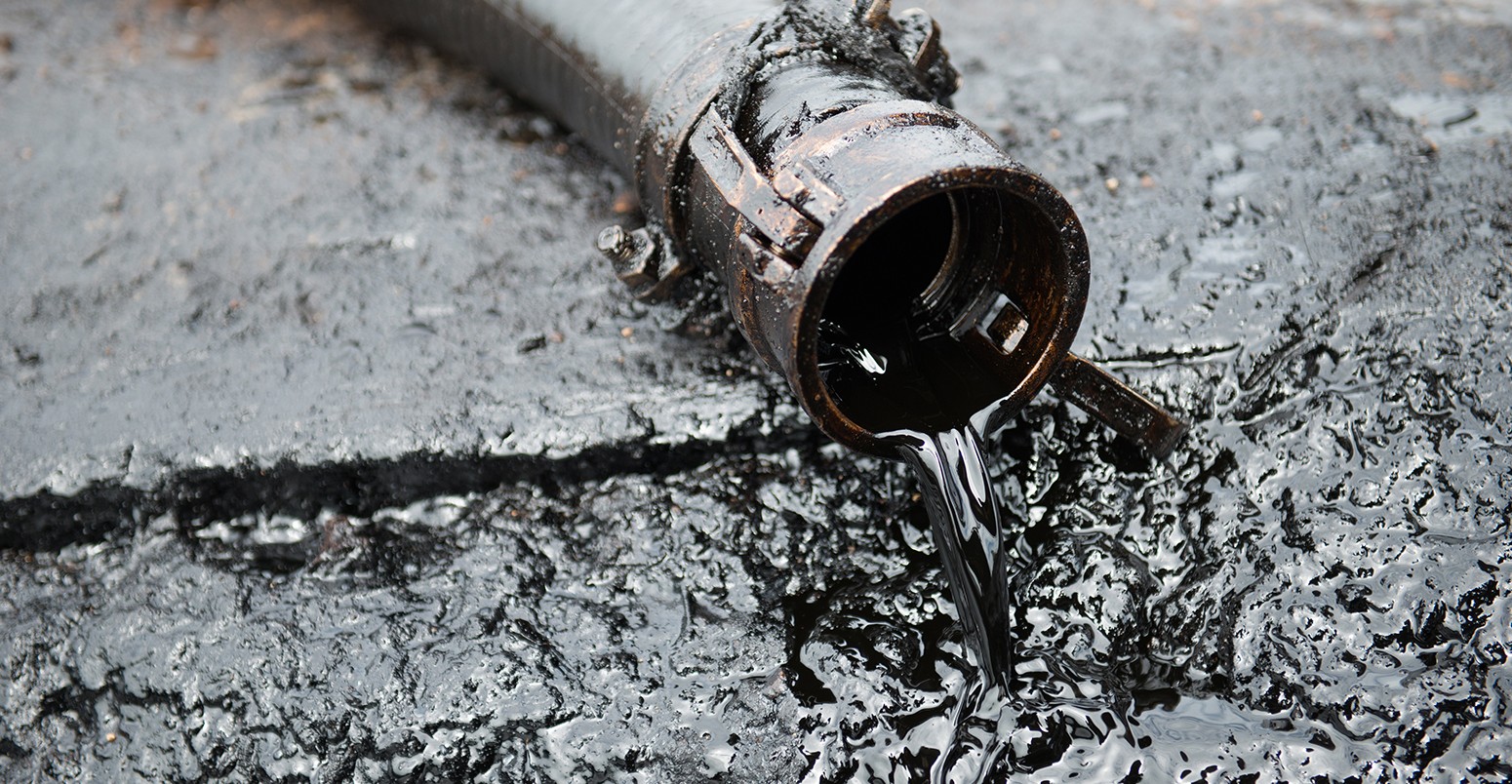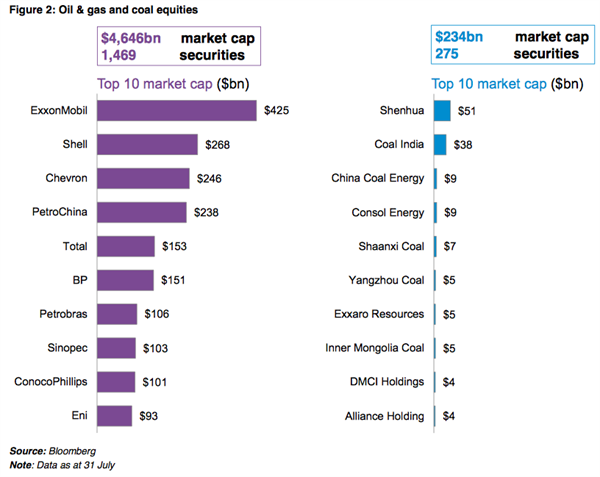
There’s a growing global campaign to stop investments in the fossil fuel industry. The British Medical Association, the World Council of Churches and Stanford University are among those pledging to take their money out of oil, coal and gas firms.
But if the idea catches on, it won’t just cause headaches for oil moguls. Investment managers will be scratching their heads too. If they can’t invest in fossil fuel firms, where should they put their money?
Clean energy firms simply aren’t big enough to soak up $5 trillion currently invested in oil and gas firms, according to a new report from Bloomberg New Energy Finance (BNEF). But divesting from coal would be much more feasible, it finds.
The enormous scale of fossil investment
The fossil fuel industry is huge. There are 1,469 oil and gas firms listed on stock exchanges around the world, worth a combined $4.65 trillion. ExxonMobil – worth $425 billion – is the second largest company in the world after Apple.
Each of the world’s top four oil and gas firms is on its own larger than the entire $220 billion stock market value of the clean energy sector, BNEF reports. The 275 listed coal firms are worth $233 billion.

Source: data from BNEF. Infographic by Carbon Brief.
The chart below shows the ten largest companies in oil and gas or coal, according to the total value of listed shares – their market capitalisation. It’s interesting to note that five of the top ten coal firms are Chinese, with only two – Consol and Alliance – from the US. Coal India, number two on the list, is state-owned.

The ten largest companies in oil and gas or coal, according to the total value of listed shares.
The carbon bubble
These assets might be worth a lot today, but if there’s strong global action to tackle climate change, there’s an argument that much of their value could be lost.
Carbon budgets would mean some of those assets becomes unburnable – and therefore worthless. That’s the argument made by organisations like Carbon Tracker, which has warned since 2011 that large portions of fossil fuel firms’ assets will be unburnable in a world limited to two degrees of warming.
In July we asked some fossil fuel firms if they were worried about climate action threatening their businesses. They weren’t.
Perhaps they would be more concerned by a mass movement to divest from their stocks. But in order for a divestment movement to take hold beyond a handful of universities and councils, there needs to be a viable alternative to the often lucrative investments in oil, coal and gas firms.
The fossil-free investment alternative
That’s where BNEF’s new report comes in. It has taken a financially-led look at the alternatives to fossil fuel investments noting that “fossil fuels are investor favourites for a reason”.
For those looking to divest while still making good returns, the first consideration is that fossil fuel investments have a history of strong performance.
BNEF looked at seven alternative trillion-dollar sectors and found that only shares in real estate firms have paid higher dividends in recent years than fossil fuel firms.
A second consideration is growth in the value of investments. The value of oil and gas stocks increased by 25 per cent in the five years to July 2014. In contrast coal stocks have halved since 2009, with some firms’ stock falling by almost 90 per cent. Even Chinese coal firms are struggling .
Tech stocks, cars and pharmaceuticals have all seen stocks surge by 100 per cent or more during the same period making these seem like more attractive investments than fossil fuels.
But if you think that’s bad news for old energy technology, BNEF highlights that oil and gas stocks have outperformed clean energy firms, now worth no more than they were five years ago.
The third consideration is the huge scale of the fossil fuel sector noted above. The 106 firms making up the “universe” of clean energy firms according to BNEF are worth just $220 billion, one-twentieth of the value of oil and gas firms. That means a simple switch from dirty carbon power to clean energy is not – at least for now – a possibility.
Clean energy investment vehicles
This clean energy sector is due to attract some $2.8 trillion in new money over the next ten years, BNEF says. This won’t be attractive to many investors, however, because wind turbines and solar panels deliver good income streams but probably won’t increase in value in the way a share in Apple might do.
BNEF says:
Many institutional investors may not find [clean energy] assets worth the effort.
That’s a problem because institutional investors hold hundreds of billions worth of fossil fuel stocks, the BNEF report shows.
New types of investment vehicle are helping to make clean energy more attractive, however. This includes things called YieldCos, for instance, a concept imported to the clean energy sector in 2013 after a long history in real estate. YieldCos exist solely to buy and hold assets such as windfarms, while passing the majority of profits to investors as dividends.
Another new development is green bonds, where firms attract direct investment through bonds linked to environmental targets or projects. However these made up just 1 per cent of corporate bonds issued in 2013, BNEF says.
Avoiding climate change
The conclusion of the BNEF report is that there is so much money invested in oil and gas firms that even if every single investor was persuaded to divest, they would find it difficult to actually do it. Fossil fuel divestment is “a $5 trillion challenge”, BNEF says.
BNEF says:
Oil and gas companies are too large, and too widely held, for divestment to be easy or fast.
In the medium term, money will continue to flow into the industry because almost everyone on the planet either uses oil and gas or would like to. Where demand continues to exist, there is money to be made.
Changing this paradigm will need dozens more YieldCos and hundreds of billions in green bonds, BNEF says.
Divesting from ‘the single greatest threat to civilisation’
But if that seems like a big ask, there might be an intriguing first step.
There is much less money invested in coal firms, and their value is plummeting . That means coal divestment – and investment in the alternatives such as clean energy – would be considerably easier.
Some climate scientists – notably James Hansen – have called coal the single greatest threat to civilisation. He says that if we stop burning coal, avoiding dangerous climate change is within our reach.
It’s fairly clear that continued coal burning is incompatible with long-term climate targets without carbon capture and storage technology. BNEF’s analysis might suggest that targeting the coal industry is one way that divestment campaigners can chalk up some climate success. But don’t get your hopes up too quickly – coal isn’t dead yet.

